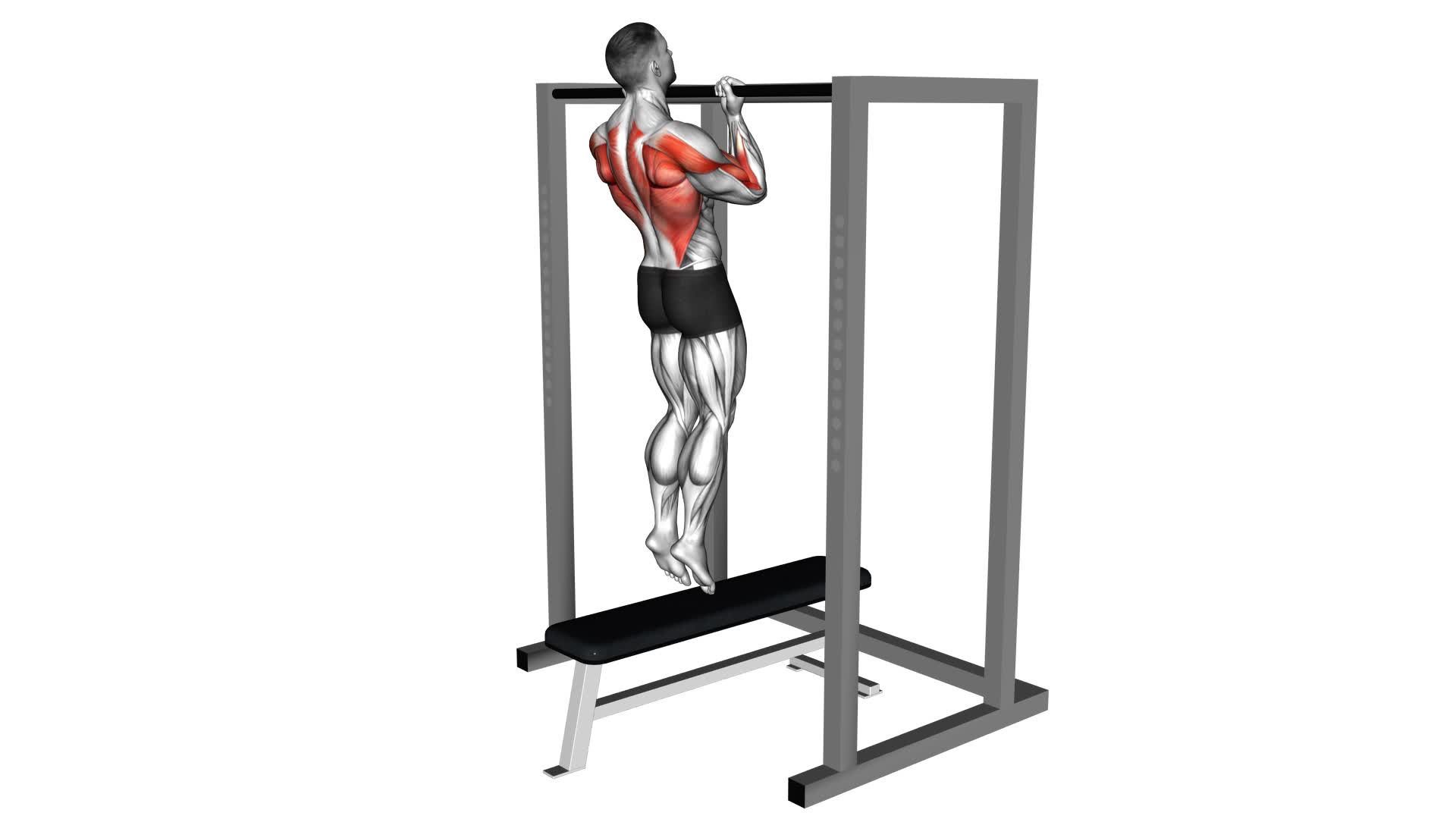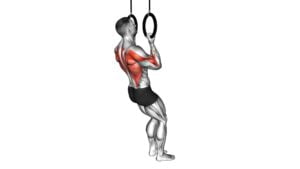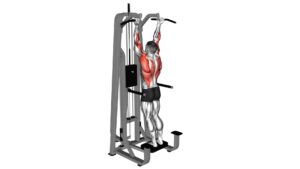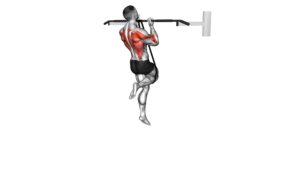Assisted Chin-Up on a Bench (Male) – Video Exercise Guide & Tips

Looking to improve your upper body strength and master the assisted chin-up on a bench? Look no further!
Watch This Exercise Video
In this video exercise guide, we'll walk you through the proper set-up, step-by-step instructions, and common mistakes to avoid, all designed specifically for males.
With our helpful tips and techniques, you'll be on your way to increasing difficulty and achieving your fitness goals in no time.
Let's get started!
Key Takeaways
- Assisted chin-up on a bench effectively strengthens upper body muscles.
- It provides support and assistance for beginners.
- The exercise can be modified with resistance bands or partner assistance.
- Assisted chin-up on a bench targets multiple muscle groups and enhances overall upper body stability.
Benefits of Assisted Chin-Up on a Bench (Male)
By performing assisted chin-ups on a bench, you can effectively strengthen your upper body muscles while receiving support and assistance. This exercise is particularly beneficial for beginners (male) who may not have the strength to perform a full chin-up on their own yet. To modify the assisted chin-up on a bench for beginners (male), you can use a resistance band or have a partner assist you by lightly holding your feet. These modifications will help reduce the amount of body weight you have to lift, making the exercise more manageable.
In addition to building upper body strength, grip strength also plays a crucial role in performing assisted chin-ups on a bench (male). A strong grip enables you to hold onto the bar more securely, enhancing your overall stability and control during the exercise. To improve your grip strength, you can incorporate specific exercises such as farmer's walks, wrist curls, and dead hangs into your training routine.
As you can see, the assisted chin-up on a bench (male) offers numerous benefits for beginners. It provides the necessary support and assistance, allowing you to gradually build strength in your upper body muscles.
Now that you understand the benefits, let's move on to the proper set-up for assisted chin-up on a bench (male).
Proper Set-Up for Assisted Chin-Up on a Bench (Male)
To properly set up for an assisted chin-up on a bench (male), position yourself with your hands shoulder-width apart on the bar. This is the starting position for the exercise.
Now, let's dive into the proper set-up for an assisted chin-up on a bench:
- Assisted chin-up variations:
- Use a resistance band: Attach a resistance band to the bar and loop it around your feet or knees. This will provide assistance as you pull yourself up.
- Use a weight-assisted machine: Some gyms have weight-assisted chin-up machines that allow you to adjust the counterweight to assist you in completing the exercise.
- Use a partner: Have a partner hold your legs or provide support as you perform the chin-up.
- Equipment needed for assisted chin-up:
- Bench: Find a stable and sturdy bench that can support your body weight.
- Chin-up bar: Look for a chin-up bar that's securely attached to a wall or a power rack.
- Proper form:
- Keep your core engaged and your back straight throughout the movement.
- Pull your body up until your chin is above the bar.
- Lower yourself slowly and with control.
Step-by-Step Guide to Performing Assisted Chin-Up on a Bench (Male)
To perform an assisted chin-up on a bench (male), continue following the proper set-up and form discussed in the previous subtopic. This exercise is a great way to target your upper body, specifically your back, biceps, and shoulders. It also helps to improve your grip strength and overall upper body strength.
One of the benefits of performing an assisted chin-up on a bench (female) is that it allows you to gradually build up your strength and progress to performing a full chin-up without assistance. By using a bench, you can modify the exercise to make it more achievable for your current fitness level.
Here is a step-by-step guide for performing an assisted chin-up on a bench (male):
- Start by standing facing the bench, with your feet shoulder-width apart.
- Place your hands on the edge of the bench, slightly wider than shoulder-width apart, with your palms facing towards you.
- Step back until your body is at a slight angle, keeping your arms straight.
- Bend your elbows and pull your chest towards the bench, squeezing your shoulder blades together.
- Lower yourself back down to the starting position with control.
- Repeat for the desired number of repetitions.
Remember to engage your core and maintain proper form throughout the exercise. As you get stronger, you can gradually decrease the amount of assistance provided by the bench until you can perform a full chin-up on your own.
Common Mistakes to Avoid While Doing Assisted Chin-Up on a Bench (Male)
Your form is crucial when performing an assisted chin-up on a bench (male) to avoid common mistakes. To ensure that you're executing this exercise correctly, here are three common mistakes to avoid and how to maintain proper form:
- Avoid using momentum: One of the most common mistakes is relying on momentum to complete the movement. Instead, focus on using your upper body strength to pull yourself up, engaging your back muscles and keeping your core tight throughout the entire exercise.
- Don't arch your back: Another mistake is arching your back excessively. This not only puts unnecessary strain on your lower back but also takes away from the effectiveness of the exercise. Keep your back straight, maintaining a neutral spine position throughout the movement.
- Don't neglect a full range of motion: It's essential to perform the chin-up using a full range of motion. This means lowering yourself until your arms are fully extended and then pulling yourself up until your chin clears the bar. Avoid cutting the movement short, as this can limit the benefits and results of the exercise.
By avoiding these common mistakes and maintaining proper form, you can maximize the effectiveness of the assisted chin-up on a bench (male) exercise.
Now, let's move on to the next section, where we'll discuss tips to progress and increase difficulty in this exercise.
Tips to Progress and Increase Difficulty in Assisted Chin-Up on a Bench (Male)
To further challenge yourself and enhance the effectiveness of the assisted chin-up on a bench (male), consider implementing these tips to progress and increase difficulty.
- Gradual Progression: Start with a bench height that allows you to comfortably perform the exercise with proper form. As you gain strength, gradually decrease the bench height to increase the challenge.
- Decrease Assistance: If you're using a resistance band for assistance, gradually switch to a lighter band or remove it altogether. This will require your muscles to work harder to lift your bodyweight.
- Increase Reps and Sets: Once you can perform a certain number of repetitions with ease, aim to increase the number of reps or sets in your workout. This will help build endurance and strengthen your muscles.
- Slow Tempo: Focus on performing the exercise with a slow and controlled tempo. This will increase the time under tension on your muscles, making the exercise more challenging.
- Targeted Muscle Groups: To further target the muscles involved in a chin-up, you can incorporate additional exercises such as lat pull-downs, bicep curls, and rows into your workout routine. These exercises will help strengthen the muscles necessary for chin-up performance.
By incorporating these progression tips, you can continuously challenge yourself and improve your strength and performance in the assisted chin-up on a bench (male).
Remember to listen to your body and progress at a pace that's suitable for you.
Frequently Asked Questions
What Are the Benefits of Doing Assisted Chin-Ups on a Bench for Males?
Assisted chin-ups on a bench offer numerous benefits for males. By using a bench, you can effectively target your upper body muscles, including the back, biceps, and shoulders.
The assistance provided by the bench allows you to gradually progress and build strength, making it a suitable exercise for beginners or those recovering from injury.
Additionally, variations in grip and hand placement can further enhance muscle engagement and promote overall upper body strength development.
How Should I Properly Set up for Assisted Chin-Ups on a Bench for Males?
To properly set up for assisted chin-ups on a bench, start by ensuring proper posture. Position yourself on the bench with your back straight and feet firmly planted on the ground.
Place your hands shoulder-width apart on the bar above you. Engage your core and pull yourself up towards the bar, using your arms and back muscles.
If you need additional support, consider using resistance bands or a spotter. These alternative variations can help you gradually build strength.
Can You Provide a Step-By-Step Guide on How to Perform Assisted Chin-Ups on a Bench for Males?
To perform assisted chin-ups on a bench, follow these steps:
First, position yourself on the bench with your feet flat on the ground and your hands gripping the bar shoulder-width apart.
Lower yourself down until your arms are fully extended.
Then, engage your back muscles and pull your body up towards the bar, focusing on using your arms and back.
As you progress, gradually reduce the assistance provided by the bench.
Remember to maintain proper form throughout the exercise.
What Are Some Common Mistakes to Avoid While Doing Assisted Chin-Ups on a Bench for Males?
When doing assisted chin-ups on a bench, it's important to be aware of common mistakes that can hinder your progress.
One mistake to avoid is using momentum to swing your body up, instead of relying on your muscles to do the work.
Another mistake isn't maintaining proper form, such as not fully extending your arms or not engaging your core.
Do You Have Any Tips on How to Progress and Increase the Difficulty in Assisted Chin-Ups on a Bench for Males?
To progress and increase the difficulty in assisted chin-ups on a bench, there are a few tips you can follow.
First, gradually decrease the assistance by using less weight or resistance bands.
You can also increase the number of repetitions or sets you do.
Another option is to try alternative exercises like negative chin-ups or weighted chin-ups.
Remember to always maintain proper form and listen to your body to avoid injury.
Conclusion
In conclusion, the assisted chin-up on a bench (male) is an effective exercise for building upper body strength and targeting the muscles in the back and arms.
By following the proper set-up and step-by-step guide, individuals can perform this exercise correctly and avoid common mistakes.
To continue progressing and increasing difficulty, it's important to gradually decrease the assistance provided and challenge oneself.
Incorporating this exercise into a regular workout routine can lead to improved strength and muscle development.

Author
Years ago, the spark of my life’s passion ignited in my mind the moment I stepped into the local gym for the first time. The inaugural bead of perspiration, the initial endeavor, the very first surge of endorphins, and a sense of pride that washed over me post-workout marked the beginning of my deep-seated interest in strength sports, fitness, and sports nutrition. This very curiosity blossomed rapidly into a profound fascination, propelling me to earn a Master’s degree in Physical Education from the Academy of Physical Education in Krakow, followed by a Sports Manager diploma from the Jagiellonian University. My journey of growth led me to gain more specialized qualifications, such as being a certified personal trainer with a focus on sports dietetics, a lifeguard, and an instructor for wellness and corrective gymnastics. Theoretical knowledge paired seamlessly with practical experience, reinforcing my belief that the transformation of individuals under my guidance was also a reflection of my personal growth. This belief holds true even today. Each day, I strive to push the boundaries and explore new realms. These realms gently elevate me to greater heights. The unique combination of passion for my field and the continuous quest for growth fuels my drive to break new ground.







